If you’re just learning how to shear a sheep, then the first thing you’ll want to do after selecting the best set of electric sheep shears, is to choose the best sheep shearing blades (comb and cutter) for your needs.
The perfect set of sheep shearing blades will differ depending upon many factors, including:
- What type of sheep are you shearing
- Why are you shearing them (harvesting wool, or are you preparing the animal for show)
- What is the condition of the sheep’s fleece
In this article I’ll introduce you to four different types of sheep shearing blades. These are the blades commonly used on Oster sheep shears (and similar, larger electric shear models). I’ll discuss what type of shearing each type of blade is best suited for.
In general, I recommend having one of each of the combs listed below. I also recommend that you purchase at least two cutters. This way you’ll be well equipped to handle any sort of shearing job that comes your way. It’s important to have a sharp cutter ready to go if (when) the first one gets dull.
But first let’s start with some basics:
How do Sheep Shearing Blades Work?
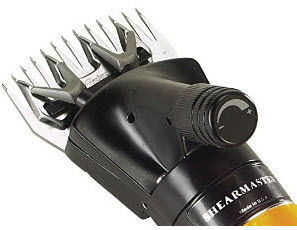
Sheep shearing blades consist of two parts:
- the comb (the bottom unit, which glides along the sheep’s body and separates the wool fibers), and
- the cutter (the top unit, which glides across the top of the comb, slicing through the wool fibers that pass between the teeth of the comb).
The top side (where the cutters glide) of the comb has a small bevel at the end of the comb’s teeth, and when your sheep shearing blades are properly adjusted the cutter will sit behind the bevel, gliding back and forth across the flat portion of the comb.
This helps to prevent your sheep from getting cut by the shears.
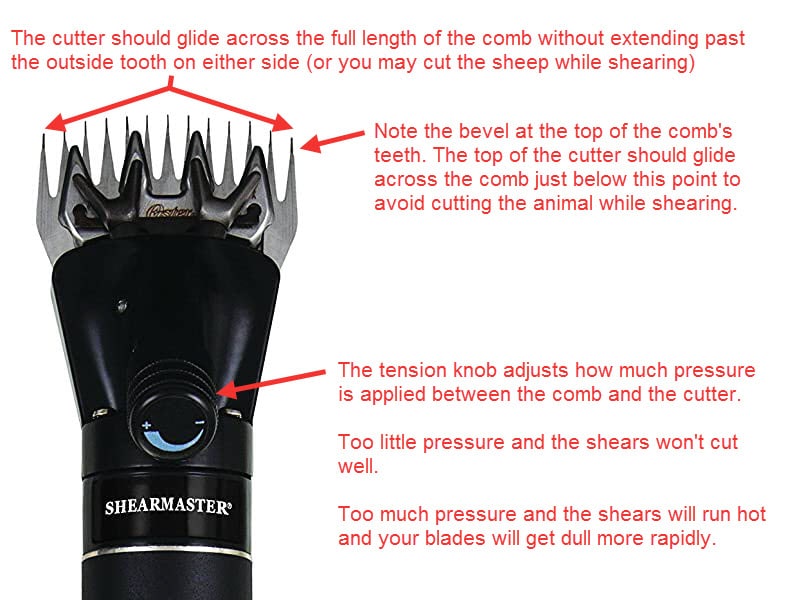
Why do Sheep Shearing Blades Come in Different Sizes?
If you have Oster sheep shears, then the cutters you buy for them can be used on any comb you purchase … so it’s actually the comb you choose which will determine whether your sheep shearing blades are appropriate for the task at hand. The combs for sheep shears come in a variety of sizes … usually measured by the number of “teeth” on the comb.
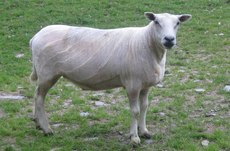
Coarse combs with fewer “teeth” are best suited for rough shearing.
If you’re shearing sheep once a year to harvest the wool, or if you’re doing rough blocking several weeks before a fair, you’ll want to use a coarse 13-tooth (or similar) comb.
The lower number of teeth allows the shears to cut through coarse, dirty or long wool much more easily. Small ridges will usually be left behind, but for this rough work that doesn’t matter.
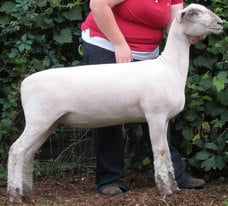
Fine combs have more “teeth” and are best suited for slick-shearing show lambs and finish trimming on meat breeds. These blades are for jobs where you don’t want any ridges in the fiber to be visible.
20- or 24- tooth sheep shearing combs are ideal for this type of application.
Fine combs like these should be used on clean, short wool (for example a Southdown that you washed a few days prior, and has 3-4 weeks of wool growth from the last time you showed it).
Types of Sheep Shearing Blades I Recommend
If you’re just buying your first set of shears and are trying to get the right combs and cutters for your clippers, here’s what I recommend:
Several Cutters So You Always Have a Sharp Set
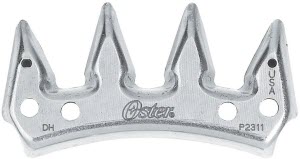
The size of your cutter will be determined by what type of electric shears you own, and the size of the shearing head. Most electric sheep shears sold now take 3″ cutters like the ones pictured.
I recommend owning at least two or three high-quality, name-brand cutters. Have all of them sharpened and ready to go when you begin shearing. This way if one set gets dull, you don’t have to drop everything to sharpen them. You can simply swap to a new cutter. I’ve always used Oster cutters (Amazon link), which work on Andis and many of the Chinese off-brand shears you can buy online. They are high quality blades that last a long time.
In most cases, putting a sharp set of cutters on a comb that you’ve been using will be virtually the same as having a sharp comb and cutter combination. The cutter blade is doing all of the work cutting the sheep’s wool, so as long as it’s sharp … you should have an easy go of it. It’s wise to sharpen your combs as well, but I always do that less frequently.
13 Tooth Comb
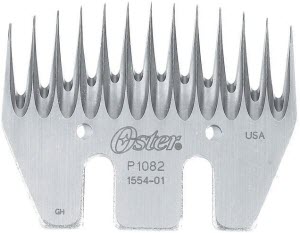
I suggest having two of these in your toolbox, because it’s the comb that gets the most work on any farm. It’s useful for annual shearing, crutching out pregnant ewes, rough blocking of your show flock, and much more.
This is a work-horse sheep shearing blade, and if you only own one comb, this should be the one that you buy (Amazon link).
I suggest having two on hand because at some point you may knock your shears off a blocking stand, or drop them. If they land on the comb, it’s not hard to break off one of the teeth. Having a spare handy will save you delays on your shearing project.
13 Tooth Flared Comb
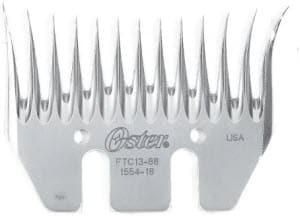
This isn’t really a requirement for your sheep shearing blade set, but I like to have one 13-tooth flared comb (Amazon link) on hand as well. It’s a matter of personal preference, but the flared comb (which has the same number of teeth as a traditional 13-tooth comb, but the outer teeth flare out to the side) is terrific for annual shearing. I like it because it will pick up more fleece in each pass with your shears, saving time.
I also like it for rough-blocking work on larger animals. Again, this is because I can save time by taking more wool with each pass of the shears. The standard 13-tooth comb is a “must-have,” and this is a “nice-to-have” blade.
20 Tooth Show Comb
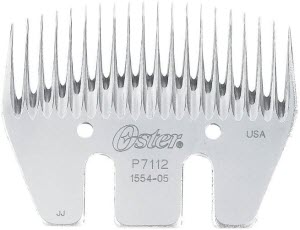
Sometimes called a “Goat Comb,” this fine, 20-tooth sheep shearing blade (Amazon link) is excellent for finish work on your show flock, and even for slick-shearing your market or club lambs, or Southdown flock.
With 7 more teeth than the 13 tooth electric sheep shear blades mentioned above, this is not recommended for rough farm work, but is an excellent choice for trimming necks and bellies on a flock of Hampshires or other meat breeds, and can be an excellent choice for slick-shearing as well.
24 Tooth Show Groomer Comb
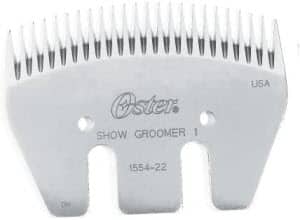
The 24-tooth, ultra-fine comb (Amazon link) is for perfect finish work on your slick-shorn show animals, and for fine touch-ups of necks and bellies on meat and wool breeds.
This is pretty much the best comb you can get for shearing jobs in which you don’t want to leave any shearing marks or ridges. With 24 teeth, this sheep shearing blade does an excellent job of separating the wool fibers. It ensures a smooth, even finish on your show stock.
Adjustments & Lubrication for Your Sheep Shearing Blades
The two most common complaints for folks who buy electric sheep shears are:
- The shears get too hot!
- The shears don’t cut the wool at all
In most cases, this isn’t the fault of your electric shears, its a matter of poor lubrication or improper adjustment.
So let’s talk about that now to help you troubleshoot some common problems (or avoid them before they occur).
How to Adjust the Tension of Sheep Shearing Blades
Electric sheep shears work because of the tension of the cutter pressing down on the comb. If the cutter isn’t pressing down hard enough, there won’t be enough tension and the shears will not cut through the wool well. Think of a pair of scissors with a loose screw so the two blades don’t really touch when you close them on paper. They’ll bend the paper instead of cutting through it.
The catch-22 of this is that if you tighten the tension TOO much, your sheep shearing blades will quickly overheat. This is because of the added friction. This makes the sheep you’re using them on very uncomfortable (and may burn the sheep’s skin). It’s also tiresome to hold very hot shears for extended periods.
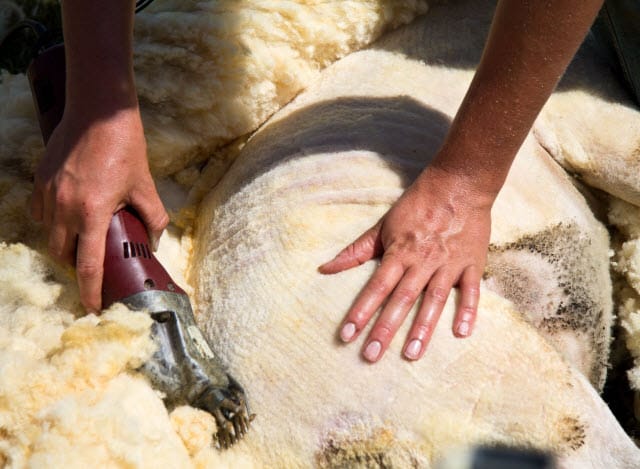
My advice to newcomers is to experiment to get the tension right (just tight enough so they cut the wool easily). Use the appropriate lubrication to ensure that the blades don’t overheat.
I have an entire article on how to maintain your shears, which you may find useful if you’re a first-time owner.
The Wool You’re Shearing Matters
Remember, if you’re shearing sheep with raw wool (an annual shearing of Romneys for example), there’s lubrication built in. Your sheep’s fleece has a lot of lanolin (the natural grease in wool) in it. Lanolin is used in many hand creams and lotions for its lubricating properties.
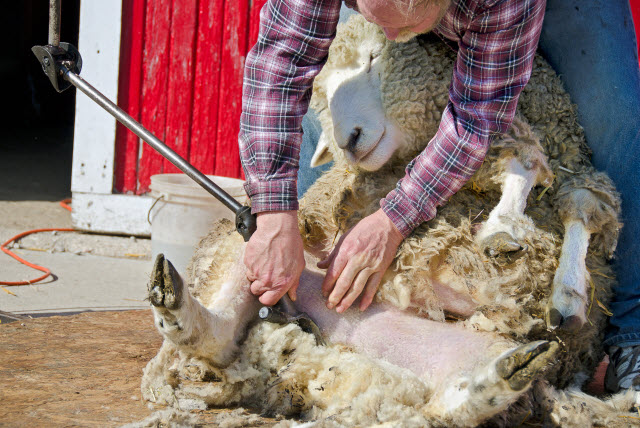
If you find that your shears are overheating in this case, and you have the tension adjusted well, it’s likely that you’re just running the shears outside of the wool too much.
First-time shearers, and beginners tend to spend a lot of time positioning their sheep, and less time with the shears cutting through the wool. It’s common to keep the shears running as you reposition the sheep.
If you find that your shears are running in the air more than they’re running while shearing your sheep, turn them off until you’re ready to begin again. The blades will last longer, and your shears will run cooler.
Oils and Sprays for Your Sheep Shear Blades

When it comes to lubrication, there are many different products on the market. Some are specialized and designed specifically to work with sheep shears (take Oster Kool Lube spray for example), and others are tried-and-true oils which shepherds have found work extremely well when shearing on the farm (Marvel Mystery Oil in a pump-action spout oil can is a personal favorite of mine – though I don’t recommend it for your show flock where it may discolor recently washed show lambs).
What if the shears are overheating and you are well-lubricated and you are confident the shears are adjusted properly? Well … there’s a good chance that your blades are dull and need to be sharpened.
This is why having an extra set of combs and cutters can come in handy.
Choosing the Best Sheep Shearing Blades for You
If you’re new to shearing sheep, I hope this short guide has been informative and helpful. Use the tips provided here as you choose the shearing equipment like lubricants, and sheep shearing blades that you’ll need for your flock.
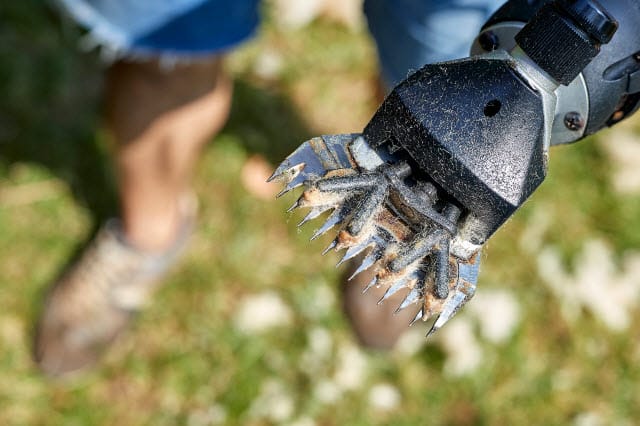
My advice for your first few times is to go slowly. Keep track of where your fingers are. And pay special attention to the teats (ewes) and genitals (both), while you’re shearing.
These areas (along with loose skin near the neck and armpits of your sheep) tend to be the most vulnerable to cuts with electric shears. It’s where many beginners cut their sheep. Good luck!

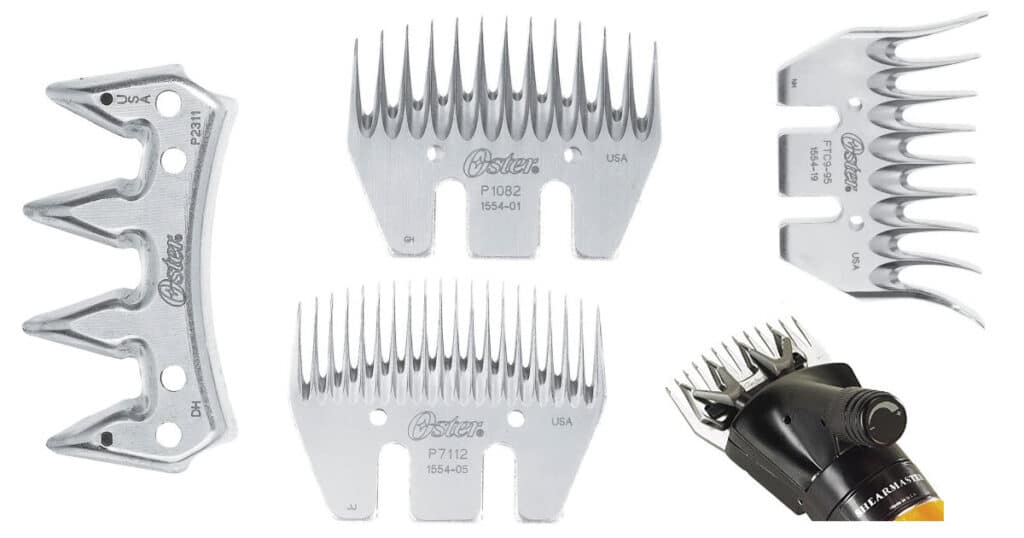
This post came just in time! I was searching for the right blades to use on my son’s 4H Lamb. Any suggestions on a medium blade to use for the face and blending? Thanks!
Hi Tiffany,
Glad this article helped! I would recommend the 20-tooth comb linked in the article above for faces and bellies … it does a nice job of providing a smooth finish blending those slicked areas in for the show ring. If you’re showing a long wool breed, you may want to try a 17-tooth comb instead, but as long as the wool is relatively clean, the 20-tooth comb is an excellent choice. Good luck!
Thanks for all the info! This was very concise and complete. I have been trying to help my daughter shear her 4 H lambs ( first time) This helps a lot.
Hi, Julie! Glad you found this guide helpful. Hope shearing goes great for you and your daughter!
Thanks for the interesting read about sheep shearing blades. It was interesting to learn that the size of the shears can depend on the number of teeth on the comb and the kind of shearing you will need, like how fewer teeth is for rough shearing. I’m a bit interested to learn more about how to decide what type of comb to use, or maybe how to test it to make sure that you picked the right one.
Thank you for the info. I have groomed my standard schnauzers for over 20 years. For the past 6, I hired someone to shear the sheep, but can’t reach him this year, so shearing those that need sheared is on me. I just needed the right blade type as I could not get the blades to go through the wool no matter what I did first time out. Now I know that I need to fix the tension! Can’t wait to shear them now! Love this kind of grooming. Some I will just roo as I did my ram several months ago when he started shedding, the rest will get clippered as I would say in the dog show world 🙂
Really informative and great information for a newby
Where will I find the guides for controlling the length of the wool when I am trimming? Guides didn’t come with the shears I bought on line.
When blade get dull, what type of sharpener are you recommending? Do you have any to offer or sale?
Wonderful Article! Just what I was looking for, in addition to your linked article for shears. My flock is still over six months away from needing shearing, but I like to be informed and prepared first!
Thank you very much!
We have 20 Shetland sheep. What clippers should we use to shear our sheep? Are there different instructions for shearing Shetlands vs other sheep? Thank you!
Great review article! Only complaint is that most of the recommendations are no longer in-stock with amazon and the message states they don’t know if they will ever be stocked again.
It is not an easy task to select the best sheep shearing blades. Sometimes for different sheep’s you really require a different set of blades. The blog contains whole details regarding that. I would suggest you go through with this if you are performing sheep shearing. Well, I have visited another site Realcountry.co.nz having some wonderful and similar information.
Can l get the cutters sharpend
Than you for your clear instructions. I have been shearing a couple of sheep and often the blades get very dirty during shearing. They are collecting grease and dirt from the wool and it’s impossible to continue shearing until I clean the blades. How can I prevent the blades from collecting dirt? Or is there an easy way to clean the blades after each sheep? Thank you!
That’s a really common issue.
One trick I’ve used successfully is that after each sheep I dip the shearing blades in a bucket of really hot water. This loosens all the grease and dirt and it floats right off the blades without having to scrape them or anything. What you want to be careful about with this is that you never want to run the shears when doing it, and you want to make sure you never get the motor of your shears wet. It’s safest to unplug them first. And only dip the blades where the grease and dirt has built up – no other part of the shears.
Running blades that are wet will quickly dull them, so after you dip them to clean them, have a towel nearby so you can get them nice and dry, then apply some oil before you start shearing again to lubricate them.
Hope this tip helps!